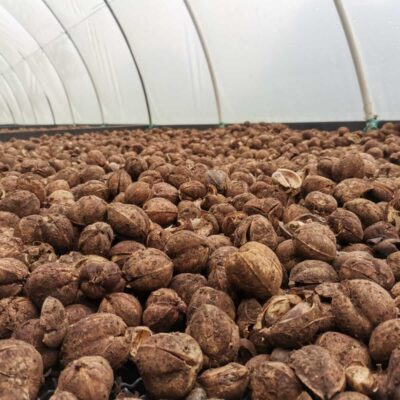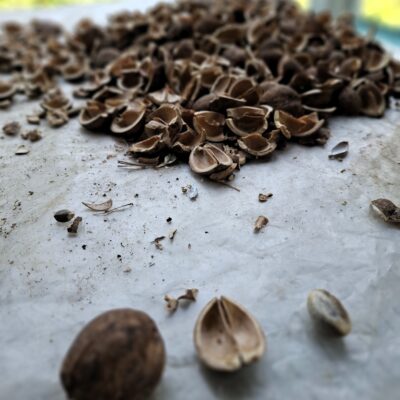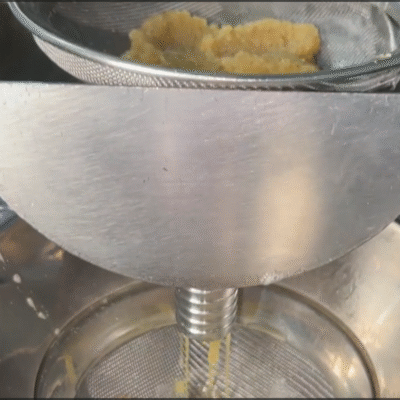Premium Cacay oil
Discover what extraordinary levels of Omega 6 can do for damaged skin.
INCI name
Caryodendron Orinocense Seed OilLinoleic acid (Omega 6) %
60 - 76Oleic acid (Omega 9) %
11 - 20Linolenic acid (Omega 3) %
2 - 3Palmitic acid %
5-7Other key component:
Vitamin A and EShelf life
36 monthsExtraction process
Cold pressedOrigin
Colombian Amazon
Cacay trees are highly productive and can start bearing nuts in as little as 4–6 years, continuing for decades. Their cultivation helps restore degraded land and enrich the soil.
The tree is well adapted to challenging conditions, making it suitable for reforestation and land rehabilitation projects.
Our growing partner incentivized the reforestation of 5000 ha by promoting Cacay’s economic potential to communities.
Everything is used from the Cacay nut: From the husks that are composted to make fertilizer to the use of shells as biofuel for machines.
Our growing partner encourages communities to plant new trees as alternatives for illegal crops. Thereby increasing food safety and economic growth for 500+ farmers and indigenous families in conflict zones.
The Cacay tree (Caryodendron orinocense) is a fast-growing, deciduous tree native to the Amazon and Orinoco regions in Colombia, Ecuador, Peru, and Venezuela. It produces cacay nuts, from which cacay oil is extracted—a prized ingredient in cosmetics for its high content of vitamin E, linoleic acid (omega-6), and retinol (natural vitamin A).
Cacay oil : Usage & Applications


Hair
Thermo-protection
Deeply Moisturizes and Restores Dry Hair
Known as a hydrating powerhouse, cacay oil penetrates deep into the hair shaft, restoring moisture and repairing damage caused by heat styling or environmental stress. It’s ideal for dry, frizzy, or damaged hair in need of intense nourishment.
Skin
Natural Anti-Aging Powerhouse
Cacay oil is rich in natural retinol (vitamin A), vitamin E, and linoleic acid, making it one of the most effective natural anti-aging oils. It helps reduce the appearance of wrinkles, fine lines, and age spots by promoting cell renewal and boosting collagen production.
It has an efficacy study demonstrating its ability to reduce the wrinkles.
Anti-oxydant facial oil
Loaded with antioxidants (twice more Vitamin E than Argan oil), cacay oil shields the skin from free radicals and environmental stressors like pollution and UV damage. This protection helps maintain healthy, youthful-looking skin and prevents signs of premature aging.
Brightens and Evens Skin Tone
Cacay oil’s natural vitamin A and vitamin E content work together to fade dark spots and improve skin texture. It helps promote a more radiant, even complexion, making it a popular ingredient in brightening skincare routines.
Get an offer
Cacay oil : Production process





Cacay Oil FAQ : Benefits, Uses & Complete Guide
How does Cacay oil compare to other facial oils like argan or rosehip?
Cacay oil contains significantly higher levels of natural retinol (Vitamin A) than popular oils like rosehip (3x more) and argan oil. It also has superior vitamin E content and a unique combination of omega 3, 6, and 9 fatty acids. Unlike heavier oils, Cacay oil absorbs quickly without leaving a greasy residue, making it suitable for all skin types including oily and acne-prone skin. Its lightweight texture and potent anti-aging properties make it more effective than many conventional facial oils.
Is Cacay oil suitable for sensitive skin and acne-prone skin?
Yes, Cacay oil is excellent for sensitive skin and acne-prone skin. Its non-comedogenic properties mean it won't clog pores, while its high linoleic acid content helps regulate sebum production and reduce breakouts. The oil's gentle, natural formulation makes it ideal for sensitive skin types, providing moisture without irritation. Many users with rosacea and eczema report improved skin condition after using Cacay oil regularly.
How should I use Cacay oil in my skincare routine?
Apply 2-3 drops of Cacay oil to clean, slightly damp skin in the evening as your final skincare step. You can use it as a standalone night serum, mix it with your moisturizer, or layer it under your night cream. For daytime use, apply a smaller amount and follow with SPF. The oil can also be used as a weekly face mask by applying a generous layer and leaving for 15-20 minutes before gently removing excess.
What makes Cacay oil a natural alternative to retinol?
Cacay oil contains naturally occurring Vitamin A and retinyl palmitate, making it a gentle alternative to synthetic retinol products. Unlike harsh chemical retinoids that can cause irritation, dryness, and photosensitivity, natural Vitamin A in Cacay oil provides anti-aging benefits without negative side effects. This makes it perfect for those seeking retinol benefits but with sensitive skin or those preferring natural skincare alternatives.
How long does it take to see results with Cacay oil?
Most users notice improved skin hydration and a healthy glow within 1-2 weeks of consistent use. Visible improvements in fine lines, skin texture, and overall radiance typically appear after 4-6 weeks of regular application. For significant anti-aging results including reduced wrinkles and improved skin elasticity, continue use for 8-12 weeks. Individual results may vary based on skin type, age, and skincare routine.
Is Cacay oil ethically and sustainably sourced?
Yes, Primegreen’s Cacay oil is sustainably and ethically sourced directly from local producers in Latin America. As a trusted supplier of natural cosmetic ingredients, Primegreen ensures that its Cacay oil is harvested through responsible, traceable supply chains that protect biodiversity and support fair partnerships with local communities. Our sourcing model aligns with UEBT standards, guaranteeing ethically sourced ingredients ideal for clean beauty and sustainable skincare formulations.
Can I use Cacay oil on my hair and body?
Absolutely! Cacay oil is versatile and can be used as a hair treatment to add shine, reduce frizz, and strengthen damaged hair. Apply a few drops to damp hair ends or use as an overnight hair mask. For body use, it's excellent for dry areas like elbows, knees, and heels. The oil's lightweight texture makes it perfect for overall body moisturizing without greasiness.
What's the difference between cold-pressed and refined Cacay oil?
Cold-pressed Cacay oil retains all its natural nutrients, vitamins, and beneficial compounds because it's extracted without heat or chemicals. This method preserves the oil's natural golden color, nutty aroma, and maximum potency. Refined oils undergo processing that strips away many beneficial properties. Our cold-pressed method ensures you receive the highest quality, most effective Cacay oil with all its natural anti-aging properties intact.
Why is Cacay oil more expensive than other facial oils?
Cacay oil's premium price reflects its rarity, sustainable sourcing, and superior anti-aging properties. The Cacay tree grows only in specific regions of the Amazon, and harvest happens only once in a year! It makes the oil scarce and valuable. The ethical harvesting process, fair trade practices, manual husking process contribute to the cost. Additionally, its exceptional nutrient profile with high natural vitamin A and vitamin E content makes it one of the most potent and effective anti-aging oils available.
